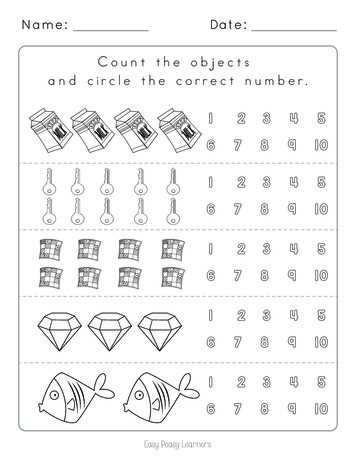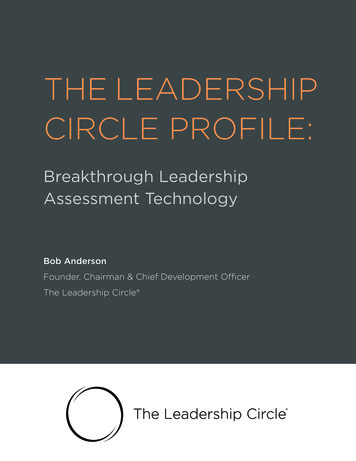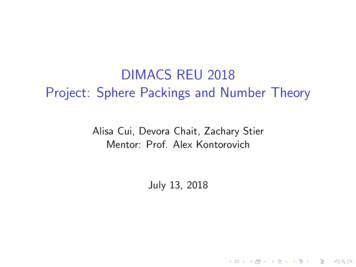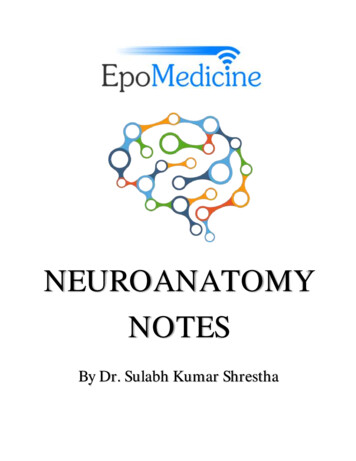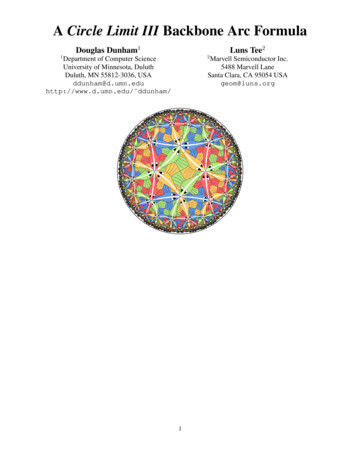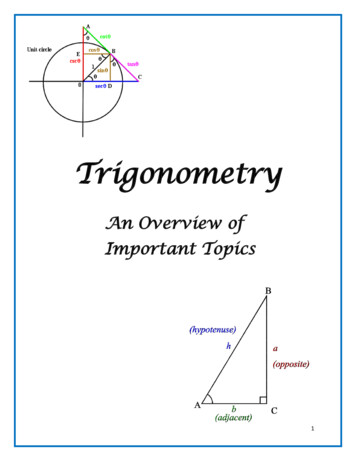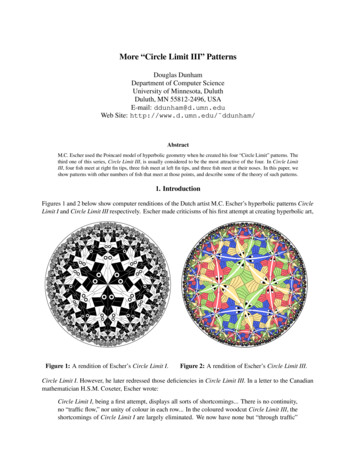
Transcription
More “Circle Limit III” PatternsDouglas DunhamDepartment of Computer ScienceUniversity of Minnesota, DuluthDuluth, MN 55812-2496, USAE-mail: ddunham@d.umn.eduWeb Site: http://www.d.umn.edu/ ddunham/AbstractM.C. Escher used the Poincaré model of hyperbolic geometry when he created his four “Circle Limit” patterns. Thethird one of this series, Circle Limit III, is usually considered to be the most attractive of the four. In Circle LimitIII, four fish meet at right fin tips, three fish meet at left fin tips, and three fish meet at their noses. In this paper, weshow patterns with other numbers of fish that meet at those points, and describe some of the theory of such patterns.1. IntroductionFigures 1 and 2 below show computer renditions of the Dutch artist M.C. Escher’s hyperbolic patterns CircleLimit I and Circle Limit III respectively. Escher made criticisms of his first attempt at creating hyperbolic art,Figure 1: A rendition of Escher’s Circle Limit I.Figure 2: A rendition of Escher’s Circle Limit III.Circle Limit I. However, he later redressed those deficiencies in Circle Limit III. In a letter to the Canadianmathematician H.S.M. Coxeter, Escher wrote:Circle Limit I, being a first attempt, displays all sorts of shortcomings. There is no continuity,no “traffic flow,” nor unity of colour in each row. In the coloured woodcut Circle Limit III, theshortcomings of Circle Limit I are largely eliminated. We now have none but “through traffic”
series, and all the fish belonging to one series have the same colour and swim after each otherhead to tail along a circular route from edge to edge. Four colours are needed so that each rowcan be in complete contrast to its surroundings. ([6], pp. 108-109, reprinted in [4])Escher had been inspired to create his “Circle Limit” patterns by a figure in one of Coxeter’s papers[2]. That figure “gave me quite a shock” according to Escher in a letter to Coxeter, since the figure showedEscher how to make “circle-limit” patterns. Some of this important Coxeter-Escher interaction is recountedin [3].In turn, Coxeter, was later inspired to write two papers explaining the mathematics behind Escher’sCircle Limit III [3, 4]. In the same issue of The Mathematical Intelligencer containing Coxeter’s secondpaper, an anonymous editor wrote the following caption for the cover of that issue, which showed Escher’sCircle Limit III:Coxeter’s enthusiasm for the gift M.C. Escher gave him, a print of Circle Limit III, is understandable. So is his continuing curiosity. See the articles on pp. 35–46. He has not, howeversaid of what general theory this pattern is a special case. Not as yet. [1]It seems that Coxeter did not describe such a general theory, or at least did not publish it. The goalsof this paper are to provide the beginnings of a general theory and to show some sample patterns. Beforedeveloping our theory, we start with a short review of some hyperbolic geometry. With this background, wecan then present a general theory of “Circle Limit III” fish patterns. Next, we examine special cases thatare more amenable to calculation, showing sample patterns along the way. Finally, we indicate directions offurther research.2. Hyperbolic GeometryEscher used the Poincaré disk model of hyperbolic geometry for his “Circle Limit” patterns. In this model,Euclidean objects are used to represent objects in hyperbolic geometry. The points of hyperbolic geometryin this model are just the (Euclidean) points within a Euclidean bounding circle. The hyperbolic linesare represented by circular arcs orthogonal to the bounding circle (including diameters). For example, thebackbone lines and other features of the fish lie along hyperbolic lines in Figure 1. The hyperbolic measureof an angle is the same as its Euclidean measure in the disk model — we say such a model is conformal — soall fish in a “Circle Limit III” pattern have roughly the same Euclidean shape. We note that equal hyperbolicdistances correspond to ever smaller Euclidean distances toward the edge of the disk. For example, all theblack fish in Figure 1 are hyperbolically the same size, as are the white fish; all the fish in Circle Limit III arethe same (hyperbolic) size. The Poincaré disk model was appealing to Escher since an infinitely repeatingpattern could be shown in a bounded area and shapes remained recognizable even for small copies of themotif, as a consequence of conformality. Escher was more interested in the Euclidean properties of the diskmodel than the fact that it could be interpreted as hyperbolic geometry.One might guess that the backbone arcs of the fish in Circle Limit III are also hyperbolic lines, but thisis not the case. Even Escher believed the backbone arcs were orthogonal to the bounding circle, but heaccurately drew them as non-orthogonal circular arcs. They are equidistant curves in hyperbolic geometry:curves at a constant hyperbolic distance from the hyperbolic line with the same endpoints on the boundingcircle. For each hyperbolic line and a given distance, there are two equidistant curves, called branches,at that distance from the line, one each side of the line. In the Poincaré disk model, those two branchesare represented by circular arcs making the same (non-right) angle with the bounding circle and having thesame endpoints as the corresponding hyperbolic line. Equidistant curves are the hyperbolic analog of smallcircles in spherical geometry: a small circle of latitude in the northern hemisphere is equidistant from theequator (a great circle or “line” in spherical geometry), and has a corresponding small circle of latitude in
the southern hemisphere the same distance from the equator. We usually do not use the term “equidistantcurve” in Euclidean geometry since parallel lines have that property (and are not curved).There is a regular tessellation, {m, n} of the hyperbolic plane by regular m-sided polygons meetingn at a vertex provided (m 2)(n 2) 4. Escher used the regular tessellations {6, 4} and {8, 3} asthe basis of his Circle Limit patterns ({6, 4} for Circle Limit I and IV, and {8, 3} for Circle Limit II andIII). Figure 3 shows the tessellation {8, 3} (heavy lines) superimposed on the Circle Limit III pattern. Asone traverses edges of this tessellation, alternately going left, then right at each vertex, one obtains a zigzagging path called a Petrie polygon. The midpoints of the edges of a Petrie polygon lie on a hyperbolicline by symmetry. The vertices of the Petrie polygon lie alternately on each of the two equidistant curvebranches associated to that line — this is shown in Figure 4 with the Petrie polygon drawn with thick lines,the “midpoint” line and the equidistant curves drawn in a medium line, all superimposed on the {8, 3}tessellation (lightest lines). Escher only used one branch for fish backbones from each pair of equidistantcurves in Circle Limit III. If he had consistently used the other branch, the pattern would have been rotatedabout the center by 45 degrees.Figure 3: The tessellation {8, 3} underlying the Cir- Figure 4: A Petrie polygon (heavy), a hyperboliccle Limit III pattern.line and two equidistant curves (medium) associatedto the {8, 3} tessellation (lightest lines).3. The General Theory of “Circle Limit III” PatternsIf we examine Circle Limit III, we see that four fish meet at right fin tips, three meet at left fin tips, and threemeet at their noses (and tails). We generalize these numbers to patterns of fish with p fish meeting at rightfins, q fish meeting at left fins, and r fish meeting at their noses. We will label such a pattern (p, q, r). SoCircle Limit III would be called (4, 3, 3) in this notation. One could conceptually “reflect” all the fish of a(p, q, r) pattern across their backbone lines to obtain a (q, p, r) pattern, but this is a true hyperbolic reflectiononly when p q.One restriction that we make is that r be odd so that the fish swim head-to-tail, in order to achieve“traffic flow.” Also, by examining the left fins of Circle Limit III, we also require that p and q be at least3, since two fins could not have tips that meet. And of course r must be at least 3 too (since r is odd and
greater than 1). Consequently, the “smallest” example of such a pattern is (3, 3, 3), realized by Escher in hisNotebook Drawing 123 [8, Page 216]. This (3, 3, 3) pattern is based on the regular tessellation {3,6} of theEuclidean plane by equilateral triangles, each triangle containing three half-fish. It is interesting that thissimpler drawing is dated several years after the much more complicated Circle Limit III. We also note thatwe do not consider Notebook Drawing 122 to be a valid “Circle Limit III” pattern, since, as in Circle LimitI, fish meet “head-on”, not head-to-tail. This pattern is based on the Euclidean tessellation of squares, eachsquare containing four half-fish, and would be denoted (4, 4, 2) if we allowed r to be even.There is another natural tessellation that we can associate with the Circle Limit III pattern, obtained bydividing the octagons in Figure 3 into four “kites” — convex quadrilaterals with two pairs of adjacent equalsides. Each kite can serve as a fundamental region for the pattern since it contains exactly the right fishpieces to assemble one complete fish. Figure 5 shows this kite tessellation superimposed on the Circle LimitIII pattern. In general for a (p, q, r) pattern, one can use a kite-shaped fundamental region with vertex anglesπ2π π 2πp , r , q , and r . We note that a quadrilateral is hyperbolic precisely when the sum of its interior anglesπ2ππis less than 2π, which translates to the following inequality for our kites: 2πp r q r 2π or inother words: p1 1q 1r 1. Figure 6 shows the kite tessellation corresponding to the (4,3,5) pattern andcontaining fish backbones along equidistant curves.Figure 5: The kite tessellation superimposed on the Figure 6: The kite tessellation (lighter lines) of theCircle Limit III pattern.(4,3,5) pattern, with fish backbones (darker arrows)along equidistant curves.4. Special CasesThere are two special cases that can be analyzed in more detail. The first case we consider is when p q,so that the fish are symmetric. In this case the backbone curves are (hyperbolic) lines. When p 6 q and thefish are not symmetric, their backbone lines bend away from the side with the larger number of fish meetingat a fin tip. For the second special case, we assume that q and r are both 3.In the first case, the fish are symmetric by reflection across the hyperbolic backbone lines. Thus we canππuse half a fish for the motif and an isosceles triangle that is half of a kite (with angles 2πp , 2r , and 2r ) for
the corresponding fundamental region. Figure 7 below shows a (4, 4, 3) pattern, but with angular fish in thestyle of Circle Limit I. Escher’s Notebook Drawing 123, mentioned above, is the “smallest” example of thisspecial case, since it is a (3, 3, 3) pattern.Figure 8 is a fin-centered version of Figure 7 that answers most of Escher’s criticisms of his Circle LimitI pattern. This pattern was obtained by the following sequence of steps. First, two of the noses of the whitefish (and tails of the black fish) were made narrower so that three white fish could also meet nose-to-nose.This solved the “traffic flow” problem (and made the white fish congruent to the black fish). The fish wouldnow all swim the same direction along a backbone line, but would be alternately colored black and white.To solve this “unity of colour” problem we use the minimum number of colors, three, to re-color the fish,yeilding the pattern of Figure 7. Finally, Figure 8 is derived from Figure 7 by hyperbolically translating a 4fold fin meeting point to the center of the bounding circle. Fortunately Escher did not follow this sequence,so that we have the beautiful Circle Limit III pattern instead.Figure 7: A (4,4,3) pattern derived from the Circle Figure 8: A (4,4,3) pattern in the style of CircleLimit I pattern.Limit I (derived from Figure 7).In the second special case, when q r 3, we can calculate the angle, ω, that the “backbone”equidistant curves make with the bounding circle. Again, Escher’s Notebook Drawing 123, a (3, 3, 3) pattern,is the “smallest” example of this special case too. Coxeter computed ω for Circle Limit III (p 4) in twoways: first by using hyperbolic trigonometry [3], and later by using Euclidean techniques [4]. We followCoxeter’s first method to calculate ω in terms of p. First, we note that the regular tessellation {2p, 3} can besuperimposed on a (p, 3, 3) pattern just as in Figure 3 (with nose and left fin points at alternate vertices ofthe 2p-gons). We next make additions to Figure 4 to obtain Figure 9: we add lines ON, OM , and N L, andlabel points L, M, N, and O. Angles 6 OM N and 6 M LN are right angles.We wish to calculate the distance N L (an overline above a line segment denotes its hyperbolic length)from the left equidistant curve to hyperbolic line passing through L and M . This distance is related to angleof parallelism, the angle between N L and the hyperbolic line N (not shown — it is different than theequidistant curve going through N and which is shown and clearly makes a right angle with N L). If αdenotes the angle of parallelism, this important relation in hyperbolic geometry is: cos α tanh N L [7,Page 402]. It turns out that angle of parallelism α is the same as the angle of intersection ω of the bounding
circle with the equidistant curve at that distance from its hyperbolic line. Thus we have:cos ω tanh N LWe can calculate N L by solving the two right triangles 4OM N and 4M LN using standard formulasfrom hyperbolic trigonometry [7, Page 403, Theorem 10.3]. First, we use 4OM N to compute M N by:cosh M N cos(ππ2π)/ sin( ) cos( )2p32p3Next, we use 4M LN to compute LN from M N by:π11tanh LN cos( ) tanh M N tanh M N 322q1 1/ cosh2 (M N )using the relation tanh2 1 1/ cosh2 . Finally, can combine these equations to obtain:cos ω When p 4, cos π8 q 2 24 ,12r1 3/4 cos 2 (consequently cos ω qπ)2p 3 2 48and ω is approximately 79.97 . Coxeterobtained a different, but equivalent expression for ω. Similarly, when p 5, cosq 3 5 540 ,π10 q 5 58 ,cos ω and ω 78.07 . Figure 10 shows a (5, 3, 3) pattern which was used as the basis for the 2003Mathematics Awareness Month poster and whose background is described in [5]. NLMOFigure 9: Two right triangles M ON and M LNadded to Figure 4 used to calculate ω.Figure 10: A (5, 3, 3) fish pattern.We can also take the limit as p goes to infinity and obtain the limiting equation cos ω 1/4 or ω 75.52 . Thus ω lies in the interval (cos 1 ( 14 ), π2 ] for finite p, q, and r. Of course we cannot actually draw apattern with an infinite number of fish meeting in the center of the disk (but an infinite number of fish finscan meet on the bounding circle, as indicated below).
The concept of (p, q, r) is symmetric in p and q, of course. Figures 11 and 12 below show examplesin which p r 3. We have put the right fin tips at the center of the disk in agreement with Escher’sCircle Limit III. Figure 11 shows a (3, 4, 3) pattern related to Circle Limit III except that the numbers of fishmeeting at left and right fin tips have been switched. Figure 12 shows a (3, 5, 3) pattern that bears the samerelationship to our Figure 10 above. Note that these figures are not just translations (or reflections) of CircleLimit III and Figure 10, since the number of fish meeting at right (and left) fins is different.There are two interesting aspects of (3, q, 3) patterns. First, the three backbone lines closest to the centerhave “straightened out” into chords of the bounding circle, resulting in a Euclidean equilateral triangle ofbackbones in the center. When I first created such a pattern (by translating to the origin a left fin meeting point of the Circle Limit III pattern) about 20 years ago, I told Coxeter that I was astonished by thisphenomenon. He replied (words to the effect):Well, you shouldn’t have been. Any triangle made up of three congruent circular arcs meetingat 60-degree angles must obviously be a Euclidean equilateral triangle.It may be possible to exploit the simple geometry of these (3, q, 3) patterns to compute ω more easily.Figure 11: A (3,4,3) pattern related to Escher’s Cir- Figure 12: A (3,5,3) pattern related to our pattern ofcle Limit III.Figure 10.A second aspect of (3, q, 3) patterns is that we can conceive of taking the limit of them as q tends toinfinity. As q goes to infinity, the left fin tips would get farther and farther from the center of the disk, untilin the limit, they would be on the bounding circle. It would theoretically be possible to draw such a pattern,but our current software can only handle finite values of p, q and r.5. Conclusions and Future WorkWe have described a general theory of (p, q, r) “Circle Limit III” patterns and shown some examples. Itwould seem to be a worthy goal to find a general formula for ω in terms of p, q, and r. With currentsoftware, (p, q, r) patterns can only be created one at a time. It would certainly be useful to have a programthat could automatically create a new (p, q, r) pattern with different values of p, q, and r from an existing
pattern. Another interesting direction would be to investigate (and draw) (p, q, r) patterns with one of q, or rbeing infinity (patterns may also exist with both q and r being infinity). A seemingly difficult problem is toautomate the process of determining a coloring for a (p, q, r) pattern that has the same color along any lineof fish and adheres to the map-coloring principle that adjacent fish have different colors.AcknowledgmentsI would like to thank Lisa Fitzpatrick and the staff of the Visualization and Digital Imaging Lab (VDIL)at the University of Minnesota Duluth. This work was also supported by a Summer 2005 VDIL Researchgrant. I would also like to thank the reviewers for a number of helpful suggestions.References[1] Anonymous, On the Cover, Mathematical Intelligencer, 18, No. 4 (1996), p. 1.[2] H.S.M. Coxeter, Crystal symmetry and its generalizations, Royal Society of Canada, (3), 51 (1957),pp. 1–13.[3] H.S.M. Coxeter, The Non-Euclidean Symmetry of Escher’s Picture ‘Circle Limit III’, Leonardo, 12(1979), pp. 19–25.[4] H.S.M. Coxeter. The trigonometry of Escher’s woodcut ”Circle Limit III”, Mathematical Intelligencer, 18, No. 4 (1996), pp. 42–46. This his been reprinted by the American Mathematical Societyat: http://www.ams.org/featurecolumn/archive/circle limit iii.html and also inM.C. Escher’s Legacy: A Centennial Celebration, D. Schattschneider and M. Emmer editors, Springer Verlag, New York, 2003, pp. 297–304.[5] D. Dunham, Hyperbolic Art and the Poster l, on the Mathematics Awareness Month 2003web site: http://www.mathaware.org/mam/03/.[6] B. Ernst, The Magic Mirror of M.C. Escher, Benedikt Taschen Verlag, Cologne, Germany, 1995. ISBN1886155003[7] M. Greenberg, Euclidean & Non-Euclidean Geometry, Third Edition: Development and History, 3ndEd., W. H. Freeman, Inc., New York, 1993. ISBN 0716724464[8] D. Schattschneider, M.C. Escher: Visions of Symmetry, 2nd Ed., Harry N. Abrams, Inc., New York,2004. ISBN 0-8109-4308-5
M.C. Escher used the Poincar e model of hyperbolic geometry when he created his four “Circle Limit” patterns. The third one of this series, Circle Limit III, is usually considered to be the most attractive of the four. In Circle Limit III, four fish meet at right fin tips, three

